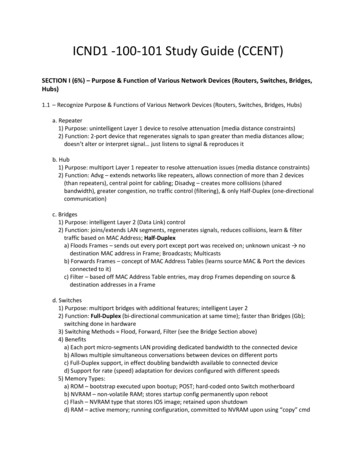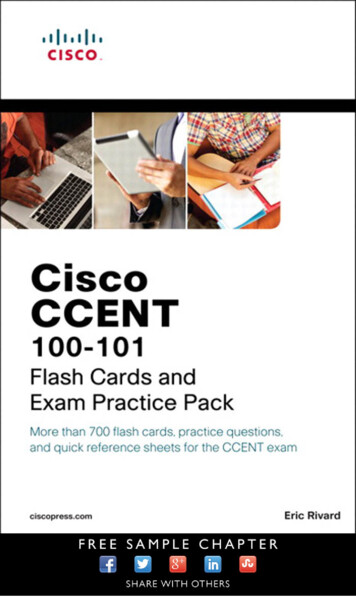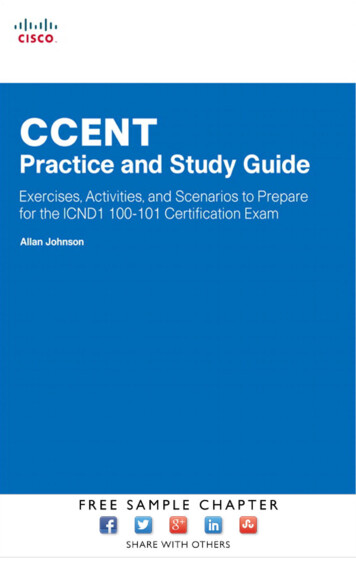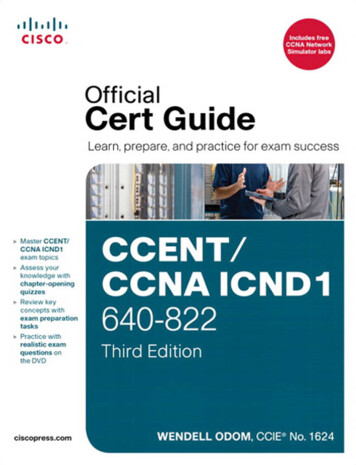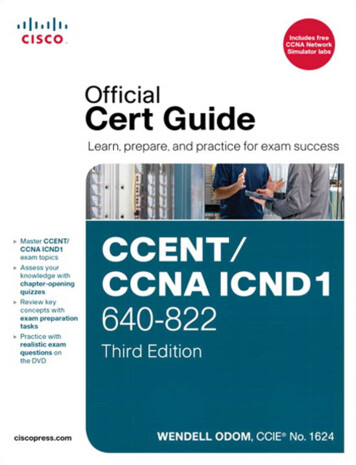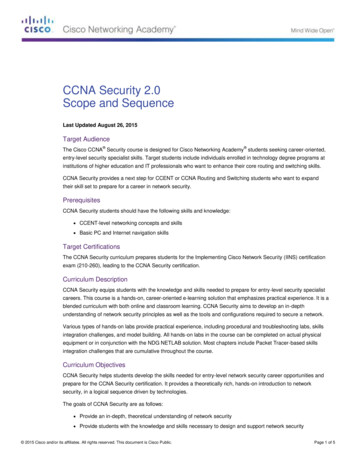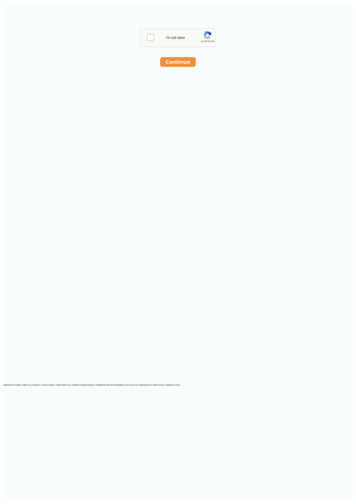
Transcription
31 Days Before YourCCENT CertificationExamSecond EditionAllan JohnsonCisco Press 800 East 96th Street Indianapolis, Indiana 46240 USA
ii31 Days Before Your CCENT Certification Exam31 Days Before Your CCENT Certification ExamSecond EditionA Day-By-Day Review Guide for the ICND1 (100-101) Certification ExamAllan JohnsonCopyright 2014 Cisco Systems, Inc.Published by:Cisco Press800 East 96th StreetIndianapolis, IN 46240 USAAll rights reserved. No part of this book may be reproduced or transmitted in any form or by anymeans, electronic or mechanical, including photocopying, recording, or by any information storage andretrieval system, without written permission from the publisher, except for the inclusion of brief quotations in a review.Printed in the United States of AmericaFirst Printing December 2013Library of Congress Control Number: 2013953096ISBN-13: 978-1-58720-453-1ISBN-10: 1-58720-453-3Warning and DisclaimerThis book is designed to provide information about exam topics for the Cisco Certified EntryNetworking Technician (CCENT) Exam 100-101 ICND1. Every effort has been made to make this bookas complete and as accurate as possible, but no warranty or fitness is implied.The information is provided on an “as is” basis. The authors, Cisco Press, and Cisco Systems, Inc. shallhave neither liability nor responsibility to any person or entity with respect to any loss or damagesarising from the information contained in this book or from the use of the discs or programs that mayaccompany it.The opinions expressed in this book belong to the author and are not necessarily those of CiscoSystems, Inc.Special SalesFor information about buying this title in bulk quantities, or for special sales opportunities (which mayinclude electronic versions; custom cover designs; and content particular to your business, traininggoals, marketing focus, or branding interests), please contact our corporate sales department at corpsales@pearsoned.com or (800) 382-3419.For government sales inquiries, please contact governmentsales@pearsoned.com.For questions about sales outside the U.S., please contact international@pearsoned.com.
iiiFeedback InformationAt Cisco Press, our goal is to create in-depth technical books of the highest quality and value. Eachbook is crafted with care and precision, undergoing rigorous development that involves the uniqueexpertise of members from the professional technical community.Readers’ feedback is a natural continuation of this process. If you have any comments regarding howwe could improve the quality of this book, or otherwise alter it to better suit your needs, you can contact us through email at feedback@ciscopress.com. Please make sure to include the book title and ISBNin your message.We greatly appreciate your assistance.PublisherPaul BogerAssociate PublisherDave DusthimerBusiness Operation Manager, Cisco PressJan CornelssenExecutive EditorMary Beth RayManaging EditorSandra SchroederSenior Development EditorChristopher ClevelandSenior Project EditorTonya SimpsonCopy EditorJohn EdwardsTechnical EditorSteve StilesEditorial AssistantVanessa EvansCover DesignerMark ShirarCompositionBronkella PublishingSenior IndexerErika MillenProofreaderMegan Wade-TaxterTrademark AcknowledgmentsAll terms mentioned in this book that are known to be trademarks or service marks have been appropriately capitalized. Cisco Press or Cisco Systems, Inc. cannot attest to the accuracy of this information. Use of a term in this book should not be regarded as affecting the validity of any trademark orservice mark.
iv31 Days Before Your CCENT Certification ExamAbout the AuthorAllan Johnson entered the academic world in 1999 after ten years as a business owner/operator to dedicate his efforts to his passion for teaching. He holds both an MBA andan M.Ed. in occupational training and development. He taught CCNA courses at thehigh school level for seven years and has taught both CCNA and CCNP courses at DelMar College in Corpus Christi, Texas. In 2003, Allan began to commit much of his timeand energy to the CCNA Instructional Support Team, providing services to NetworkingAcademy instructors worldwide and creating training materials. He now works full time forCisco Networking Academy as a learning systems developer.About the Technical ReviewerSteve Stiles is a Cisco Networking Academy Instructor for Rhodes State College and aCisco Certified Instructor Trainer, having earned CCNA Security and CCNP level certifications. He was the recipient of the 2012 Outstanding Teacher of the Year award by the OhioAssociation of Two Year Colleges and co-recipient of the Outstanding Faculty of the Yearaward at Rhodes State College.
vDedicationFor my wife, Becky. Without the sacrifices you made during the project, this work wouldnot have come to fruition. Thank you for providing me the comfort and resting place onlyyou can give.
vi31 Days Before Your CCENT Certification ExamAcknowledgmentsWhen I began to think of whom I would like to have as a technical editor for this work,Steve Stiles immediately came to mind. With his instructor and industry background, aswell as his excellent work building activities for the new Cisco Networking Academy curriculum, he was an obvious choice. Thankfully, when Mary Beth Ray contacted him, he waswilling and able to do the arduous review work necessary to make sure that you get a bookthat is both technically accurate and unambiguous.This book is a concise summary of the work of Cisco Press CCNA authors. WendellOdom’s Cisco CCENT/CCNA ICND1 100-101 Official Cert Guide and AnthonySequeira’s Interconnecting Cisco Network Devices, Part 1 (ICND1) Foundation LearningGuide were two of my main sources. The different approaches that these two authors—both CCIEs—take toward the CCNA material gives the reader the breadth and the depthneeded to master the CCNA exam topics.The Cisco Networking Academy authors for the online curriculum and series ofCompanion Guides take the reader deeper, past the CCNA exam topics, with the ultimategoal of not only preparing the student for CCNA certification, but also for more advancedcollege-level technology courses and degrees. Thank you especially to Amy Gerrie and herteam of authors—Rick Graziani, Wayne Lewis, and Bob Vachon—for their excellent treatment of the material; it is reflected throughout this book.Mary Beth Ray, executive editor, amazes me with her ability to juggle multiple projects atonce, steering each from beginning to end. I can always count on her to make the toughdecisions. Thank you, Mary Beth, for bringing this project to me.This is my fifth project with Christopher Cleveland as development editor. His dedication toperfection pays dividends in countless, unseen ways. Thank you again, Chris, for providingme with much needed guidance and support. This book could not be a reality without yourpersistence.
viiContents at a GlanceIntroductionxxiiiDay 31 Network Devices, Components, and ApplicationsDay 30 Networking Models and Data Flow 17Day 29 Ethernet and Media Access Control 31Day 28 Switching Concepts and OperationDay 27 Basic Switch ConfigurationDay 26 VLAN Concepts415363Day 25 VLAN and Trunking ConfigurationDay 24 The IPv4 Address7179Day 23 IPv4 Subnetting and VLSM85Day 22 IPv6 Addressing Concepts95Day 21 Implementing IPv6 AddressingDay 20 Basic Routing Concepts109117Day 19 Dynamic Routing Protocols125Day 18 Basic Router Configuration: IPv4133Day 17 Basic Router Configuration: IPv6145Day 16 Static and Default Route ConfigurationDay 15 Single-Area OSPFv2169Day 14 Single-Area OSPFv3185Day 13 Inter-VLAN Routing ConfigurationDay 12 DHCP ConfigurationDay 11 ACL Concepts195205221Day 10 Basic ACL Configuration227Day 9NAT237Day 8Basic Device SecurityDay 7Switch Security Configuration2492591531
viii31 Days Before Your CCENT Certification ExamDay 6Troubleshoot IP Addressing IssuesDay 5Troubleshoot VLAN IssuesDay 4Troubleshoot Trunking IssuesDay 3Troubleshoot ACL IssuesDay 2Troubleshoot Layer 1 IssuesDay 1CCENT Skills Review and Practice273Index311277281Exam Day 307Post-Exam Information267309287295
ixContentsIntroductionxxiiiDay 31: Network Devices, Components, and ApplicationsCCENT 100-101 ICND1 Exam TopicsKey Points11Devices 1Switches 2Routers 3Physical Layer4Network Media Forms and Standards4LAN Device Connection Guidelines 6LANs and WANsNetworking Icons78Physical and Logical TopologiesCisco Borderless Network89Hierarchy in a Borderless NetworkNetwork Documentation1011Classification of Network ApplicationsUser Application Interaction1212Common Network Applications13Growth of Network-Based ApplicationsQuality of Service1314Increased Network Usage14The Impact of Voice and Video on the NetworkStudy Resources15Day 30: Networking Models and Data FlowCCENT 100-101 ICND1 Exam TopicsKey Points171717The OSI and TCP/IP ModelsOSI Layers1718TCP/IP Layers and Protocols19Protocol Data Units and EncapsulationThe TCP/IP Application Layer2120141
x 31 Days Before Your CCENT Certification ExamThe TCP/IP Transport LayerTCP Header23Port Numbers23Error RecoveryFlow Control222425Connection Establishment and Termination 25UDP26The TCP/IP Internet Layer27The TCP/IP Network Access Layer27Data Encapsulation Summary 29Study Resources 30Day 29: Ethernet and Media Access Control 31CCENT 100-101 ICND1 Exam TopicsKey Topics3131Ethernet Overview31Legacy Ethernet Technologies32CSMA/CD 33Legacy Ethernet Summary 34Current Ethernet Technologies 34UTP Cabling 34Benefits of Using Switches 36Ethernet Addressing 36Ethernet Framing 37The Role of the Physical Layer 38Study Resources 39Day 28: Switching Concepts and Operation 41CCENT 100-101 ICND1 Exam Topics 41Key Topics 41Evolution to Switching 41Switching Logic 42Collision and Broadcast Domains 43
xiFrame Forwarding 43Switch Forwarding Methods 44Symmetric and Asymmetric Switching 44Memory Buffering 44Layer 2 and Layer 3 Switching 44Accessing and Navigating the Cisco IOS45Connecting to Cisco Devices 45CLI EXEC Sessions 46Using the Help Facility 46CLI Navigation and Editing Shortcuts 47Command History 48IOS Examination Commands 48Subconfiguration Modes 49Storing and Erasing Configuration Files 49Study Resources 51Day 27: Basic Switch Configuration 53CCENT 100-101 ICND1 Exam Topics 53Key Topics 53Basic Switch Configuration Commands 53Half-Duplex, Full-Duplex, and Port Speed 55Automatic Medium-Dependent Interface Crossover (auto-MDIX) 56Configuring SSH Access56Verifying Network ConnectivityStudy Resources5861Day 26: VLAN Concepts63CCENT 100-101 ICND1 Exam TopicsKey Points63VLAN Concepts 63Traffic Types64Types of VLANs 65Voice VLAN ExampleTrunking VLANs666563
xii 31 Days Before Your CCENT Certification ExamDynamic Trunking ProtocolStudy Resources6869Day 25: VLAN and Trunking ConfigurationCCENT 100-101 ICND1 Exam TopicsKey Points717171Sample Topology71VLAN Configuration and Verification CommandsConfiguring and Verifying TrunkingStudy Resources7578Day 24: The IPv4 Address79CCENT 100-101 ICND1 Exam TopicsKey Topics7979IPv4 Addressing79Header Format79Classes of Addresses80Purpose of the Subnet MaskPrivate and Public IP AddressingStudy Resources818283Day 23: IPv4 Subnetting and VLSM85CCENT 100-101 ICND1 Exam TopicsKey Topics728585Subnetting in Four Steps85Determine How Many Bits to BorrowDetermine the New Subnet MaskDetermine the Subnet Multiplier868787List the Subnets, Host Ranges, and Broadcast AddressesSubnetting Example 188Subnetting Example 288Subnetting Example 389VLSM89Summarizing Subnet Addresses 91Study Resources 9387
xiiiDay 22: IPv6 Addressing Concepts95CCENT 100-101 ICND1 Exam TopicsKey Topics9595Overview and Benefits of IPv6The IPv6 Protocol9596IPv6 Address Types97Unicast 98Multicast 104Anycast 106Study Resources 106Day 21: Implementing IPv6 Addressing 109CCENT 100-101 ICND1 Exam Topics 109Key Topics 109Representing the IPv6 Address 109Conventions for Writing IPv6 Addresses 109Conventions for Writing IPv6 Prefixes 110IPv6 Subnetting 111Subnetting the Subnet ID 111Subnetting into the Interface ID 112EUI-64 Concept 112Stateless Address Autoconfiguration 113Migration to IPv6 114Study Resources 115Day 20: Basic Routing Concepts 117CCENT 100-101 ICND1 Exam Topics 117Key Topics 117Packet Forwarding 117Path Determination and Switching Function Example 118Routing Methods 119Classifying Dynamic Routing Protocols 120IGP and EGP 121Distance Vector Routing Protocols 121Link-State Routing Protocols 122
xiv31 Days Before Your CCENT Certification ExamClassful Routing Protocols122Classless Routing Protocols 122Study Resources 123Day 19: Dynamic Routing Protocols125CCENT 100-101 ICND1 Exam TopicsKey Topics125125Dynamic Routing MetricsAdministrative Distance125126IGP Comparison SummaryRouting Loop Prevention128128Link-State Routing Protocol FeaturesBuilding the LSDB129129Calculating the Dijkstra Algorithm130Convergence with Link-State Protocols 131Study Resources 132Day 18: Basic Router Configuration: IPv4CCENT 100-101 ICND1 Exam TopicsKey Topic133133Basic Router Configuration with IPv4Study Resources133142Day 17: Basic Router Configuration: IPv6CCENT 100-101 ICND1 Exam TopicsKey Topic133145145145Basic Router Configuration with IPv6145Verifying IPv4 and IPv6 Network ConnectivityStudy Resources151Day 16: Static and Default Route ConfigurationCCENT 100-101 ICND1 Exam TopicsKey Topics148153153Static and Default Routing Overview153153
xvIPv4 Static Route Configuration154IPv4 Static Routes Using the “Next-Hop” ParameterIPv4 Static Routes Using the Exit Interface ParameterIPv4 Default Route Configuration158IPv4 Summary Static Route Configuration 161IPv6 Static Routing162IPv6 Static Route Configuration164IPv6 Default Route Configuration165IPv6 Summary Static Route Configuration 166Study Resources167Day 15: Single-Area OSPFv2169CCENT 100-101 ICND1 Exam TopicsKey Topics169169OSPF Operation169OSPF Message FormatOSPF Packet Types169170Neighbor Establishment 170Link-State Advertisements 172OSPF DR and BDR 173OSPF Algorithm173Link-State Routing Process 174Single-Area OSPFv2 ConfigurationThe router ospf CommandThe network CommandRouter ID175176176177Passive Interfaces177Modifying the OSPF MetricVerifying OSPFv2180Study Resources184178156157
xvi31 Days Before Your CCENT Certification ExamDay 14: Single-Area OSPFv3185CCENT 100-101 ICND1 Exam TopicsKey Topics185185OSPFv2 Versus OSPFv3185Similarities Between OSPFv2 and OSPFv3 185Differences Between OSPFv2 and OSPFv3Single-Area OSPFv3 ConfigurationThe Router ID in OSPFv3Verifying OSPFv3189Study Resources192186188Day 13: Inter-VLAN Routing ConfigurationCCENT 100-101 ICND1 Exam TopicsKey Topics186195195195Inter-VLAN Routing Concepts195Legacy Inter-VLAN RoutingRouter on a Stick195196Multilayer Switch 197Router on a Stick Configuration and Verification197Multilayer Switch Inter-VLAN Routing Configuration and VerificationCreating Additional SVIs200Configuring a 2960 to Route Between VLANsStudy Resources204Day 12: DHCP Configuration205CCENT 100-101 ICND1 Exam TopicsKey TopicsDHCPv4201205205205DHCPv4 Configuration Options206Configuring a Router as a DHCPv4 Server206Configuring a Router to Relay DHCPv4 RequestsConfiguring a Router as a DHCPv4 Client 211210200
xviiDHCPv6212SLAAC 212Stateless DHCPv6 214Stateful DHCPv6 214Stateless and Stateful DHCPv6 Operation 214DHCPv6 Configuration Options216Configuring a Router as a Stateless DHCPv6 ServerConfiguring a Router as a Stateful DHCPv6 ServerStudy Resources217218Day 11: ACL Concepts221CCENT 100-101 ICND1 Exam TopicsKey Topics216221221ACL Operation221Defining an ACL221Processing Interface ACLs 221List Logic with IP ACLs 222Planning to Use ACLsTypes of ACLs223224ACL Identification225ACL Design GuidelinesStudy Resources225226Day 10: Basic ACL Configuration227CCENT 100-101 ICND1 Exam TopicsKey Topics227227Configuring Standard Numbered ACLs227Standard Numbered ACL: Permit Specific NetworkStandard Numbered ACL: Deny a Specific Host228228Standard Numbered ACL: Deny a Specific Subnet229Standard Numbered ACL: Deny Telnet or SSH Access to the RouterConfiguring Extended Numbered ACLs230Extended Numbered ACL: Deny FTP from Subnets231Extended Numbered ACL: Deny Only Telnet from Subnet231229
xviii31 Days Before Your CCENT Certification ExamConfiguring Named ACLs231Standard Named ACL Steps and Syntax232Standard Named ACL: Deny a Single Host from a Given SubnetExtended Named ACL Steps and Syntax233Adding Comments to Named or Numbered ACLsVerifying ACLs234Study ResourcesDay 9: NAT236237CCENT 100-101 ICND1 Exam TopicsKey Topics237NAT Concepts237A NAT Example239Dynamic and Static NATNAT OverloadNAT Benefits240240241NAT Limitations241Configuring Static NAT242Configuring Dynamic NAT243Configuring NAT Overload244Verifying NAT245Troubleshooting NATNAT for IPv6246247IPv6 Private Address SpacePurpose of NAT for IPv6Study Resources247247248Day 8: Basic Device Security249CCENT 100-101 ICND1 Exam TopicsKey Topics237249249Network Security Overview249Physical Security 249Types of Security Vulnerabilities 250233232
xixMitigating Network Attacks 250Security Best Practices 250Securing the IOS 251Passwords, Authentication, Timers, and SSHBanners251253Disable Services 255HTTP Service 255CDP255Small Services256Network Time ProtocolStudy Resources256258Day 7: Switch Security Configuration259CCENT 100-101 ICND1 Exam TopicsKey Topics259259Configuring Port Security259Restoring a Port After a Violation261Changing the Native and Management VLANs263Shutting Down and Securing Unused InterfacesStudy Resources264Day 6: Troubleshoot IP Addressing IssuesCCENT 100-101 ICND1 Exam TopicsKey Topics267267267Troubleshooting MethodologyDefault Gateway267267Duplicate IP AddressesDHCP Issues264268268Resolve IPv4 Address Conflicts268Test Connectivity Using a Static IP AddressVerify Switch Port Configuration269269Test DHCPv4 Operation on the Same Subnet or VLANInter-VLAN Routing and IP Addressing IssuesStudy Resources271269269
xx31 Days Before Your CCENT Certification ExamDay 5: Troubleshoot VLAN Issues273CCENT 100-101 ICND1 Exam TopicsKey Topics273273VLAN Troubleshooting273Disabled VLANs 274Study Resources275Day 4: Troubleshoot Trunking Issues277CCENT 100-101 ICND1 Exam TopicsKey Topics277277Trunking Troubleshooting OverviewCheck Both Ends of a Trunk277277Check Trunking Operational States 278Study Resources 279Day 3: Troubleshoot ACL Issues281CCENT 100-101 ICND1 Exam TopicsKey Topics281281Troubleshooting ACLs281Problem 1: Host Has No ConnectivityProblem 2: Denied Protocols283Problem 3: Telnet Is Allowed #1284Problem 4: Telnet Is Allowed #2284Problem 5: Telnet Is Allowed #3285Study Resources286Day 2: Troubleshoot Layer 1 Issues287CCENT 100-101 ICND1 Exam TopicsKey Topics282287287Media Issues287Interface Status and the Switch ConfigurationInterface Status Codes288288Duplex and Speed Mismatches289Common Layer 1 Problems On “Up” InterfacesCDP as a Troubleshooting ToolStudy Resources293291290
xxiDay 1: CCENT Skills Review and PracticeKey Topics295295Introduction295Topology DiagramAddressing Table295296VLANs and Port Assignments TableISP Configuration296297Implementation 297IPv4 Addressing Configuration Requirements 297HQ-Sw Configuration Requirements 297HQ Configuration Requirements 298B1 and B2 Configuration Requirements 298Staff 299Verification299Your Notes300Answer Scripts302CCENT Skills ChallengeExam Day305307What You Need for the Exam307What You Should Receive After CompletionSummary308Post-Exam Information309Receiving Your CertificateDetermining Career Options309309Examining Certification OptionsIf You Failed the ExamSummaryIndex 311310310310307
xxii31 Days Before Your CCENT Certification ExamIcons Used in This BookDesktopComputerLaptopServerLAN SwitchRouterMultilayer SwitchIP PhoneFirewallHubWirelessRouterWirelessAccess PointLANMediaWANMediaWirelessMediaCommand Syntax ConventionsThe conventions used to present command syntax in this book are the same conventionsused in the IOS Command Reference. The Command Reference describes these conventionsas follows:QBoldface indicates commands and keywords that are entered literally as shown. Inactual configuration examples and output (not general command syntax), boldfaceindicates commands that are manually input by the user (such as a show command).QItalic indicates arguments for which you supply actual values.QVertical bars ( ) separate alternative, mutually exclusive elements.QSquare brackets ([ ]) indicate an optional element.QBraces ({ }) indicate a required choice.QBraces within brackets ([{ }]) indicate a required choice within an optional element.
xxiiiIntroductionYou are almost there! If you’re reading this Introduction, you’ve probably already spent aconsiderable amount of time and energy pursuing your CCENT certification. Regardlessof how you got to this point in your travels through your CCENT studies, 31 Days BeforeYour CCENT Certification Exam most likely represents the last leg of your journey onyour way to the destination: to become a Cisco Certified Entry Networking Technician.However, if you are like I am, you might be reading this book at the beginning of yourstudies. If such is the case, this book provides you with an excellent overview of the material that you must now spend a great deal of time studying and practicing. However, I mustwarn you: Unless you are extremely well-versed in networking technologies and have considerable experience configuring and troubleshooting Cisco routers and switches, this bookwill not serve you well as the sole resource for CCENT exam preparation. Therefore, let mespend some time discussing my recommendations for study resources.Study ResourcesCisco Press offers an abundance of CCNA-related books to serve as your primary sourcefor learning how to install, configure, operate, and troubleshoot small- to medium-sizerouted and switched networks.Primary ResourcesFirst on the list must be Wendell Odom’s Cisco CCENT/CCNA ICND1 100-101 OfficialCert Guide (ISBN: 9781587143854). If you do not buy any other books, buy this one.Wendell’s method of teaching, combined with his technical expertise and down-to-earthstyle, is unsurpassed in our industry. As you read through his books, you sense that he issitting right there next to you walking you through the material. The practice exams andstudy materials on the DVD in the back of the book are worth the price of the book. Thereis no better resource on the market for a CCNA candidate.Next on the list must be Anthony Sequeira’s Interconnecting Cisco Network Devices,Part 1 (ICND1) Foundation Learning Guide (ISBN: 9781587143762). This book is indispensable to those students who take the first of two Cisco-recommended training classfor CCNA preparation: Interconnecting Cisco Network Devices 1 (ICND1). These courses,available through Cisco Training Partners in a variety of formats, are usually of a veryshort duration (one to six weeks) and are geared toward the industry professional alreadyworking in the field of networking. Anthony’s book serves the reader well as a concise, butthorough, treatment of the CCENT exam topics. His method and approach often differ andcomplement Wendell’s approach. I recommend that you also refer to this book.If you are a Cisco Networking Academy student, you are blessed with access to the onlineversion of the CCNA Routing and Switching curriculum and the wildly popular PacketTracer network simulator. Although there are currently two paths for the CCNA curriculum,I used the Introduction to Networking (ITN) and Routing and Switching Essential (RSE)courses in my daily review of the exam topics. ITN introduces basic concepts of computernetworks, including deep dives into the seven layers of the OSI model, IP addressing, andthe fundamentals of Ethernet. Successfully completing the course means that you shouldbe able to build small LANs and implement basic addressing and configurations on routers
xxiv31 Days Before Your CCENT Certification Examand switches. RSE expands on ITN, taking the student further into basic router and switchconfiguration. Successfully completing the course means that you should be able to configure and troubleshoot routers and switches using a variety of technologies including RIPv2,single-area OSPF, VLANs, and inter-VLAN routing for both IPv4 and IPv6 networks. Tolearn more about CCNA Routing and Switching courses and to find an Academy near you,visit www.netacad.com.However, if you are not an Academy student but would like to benefit from the extensiveauthoring done for these courses, you can buy any or all the CCNA Routing and SwitchingCompanion Guides (CG) and Lab Manuals (LM) of the Academy’s popular online curriculum. Although you will not have access to the Packet Tracer network simulator software, you will have access to the tireless work of an outstanding team of Cisco AcademyInstructors dedicated to providing students with comprehensive and engaging CCNA preparation course material. The titles and ISBNs for the CCNA Routing and Switching CGs andLMs are as follows:QIntroduction to Networks Companion Guide (ISBN: 9781587133169)QIntroduction to Networks Lab Manual (ISBN: 9781587133121)QRouting and Switching Essentials Companion Guide (ISBN: 9781587133183)QRouting and Switching Essentials Lab Manual (ISBN: 9781587133206)You can find these books at www.ciscopress.com by clicking the Cisco NetworkingAcademy link.Supplemental ResourcesIn addition to the book you hold in your hands, there are four more supplemental resourcesI recommend to augment your final 31 days of review and preparation.First, a plug for my own book, the CCENT Practice and Study Guide, Exercises,Activities and Scenarios to Prepare for the ICND1/CCENT (100-101) CertificationExam (ISBN: 9781587133459). The subtitle is a concise summary of what you will get.Although an appropriate resource for anyone, this book is specifically geared toward theCisco Networking Academy instructors and students who want a resource to supplementthe online curriculum. Mirroring the chapter layout of the first two online courses, theCCENT PSG offers exercises that help you learn the concepts and configurations that arecrucial to your success as a CCENT candidate.Second, Wendell Odom and Sean Wilkins have created over 250 structured labs that areavailable in the Cisco CCENT ICND1 100-101 Network Simulator (ISBN: 9780789750433).These simulations map precisely to chapters in his book, but are also a great practiceresource for anyone. The four types of labs in this product present you with progressivelymore difficult real-world challenges. Skill builder labs help you practice short, focusedconfiguration tasks. Subnetting exercises help you improve the speed and accuracy of yoursubnetting calculations. Complex Configuration Scenario labs present realistic multilayered,multitechnology configuration tasks. Finally, challenging Troubleshooting Scenario labsprovide you with an opportunity to test your problem identification and resolution skills. Ifyou need that extra edge or are struggling with a particular configuration or troubleshooting concept, you’ll find these simulations very helpful.
xxvThird, Eric Rivard is the author of Cisco CCENT ICND1 100-101 Flash Cards and ExamPractice Pack (ISBN: 9781587203992). The text portion of the book includes over 450flash cards that quickly review exam topics in bite-sized pieces. Also included is over 100pages in the Quick Reference Guide, which is designed for late-stage exam preparation. Andon the included CD, you will find a test engine with over 150 CCENT practice exam questions.NOTE: If you are certain that you will be also pursuing your CCNA certification, the moreeconomical purchase might be to buy the Cisco CCNA Routing and Switching 200-120Flash Cards and Exam Practice Pack (ISBN: 9781587204005). The first half of this book isa repeat of the CCENT version.Fourth, there is Scott Empson’s very popular CCNA Routing and Switching PortableCommand Guide, Third Edition (ISBN: 9781587204302). This guide is way more than justa listing of commands and what they do. Yes, it summarizes all the CCNA certification-levelIOS commands, keywords, command arguments, and associated prompts. But it also provides you with tips and examples of how to apply the commands to real-world scenarios.Configuration examples throughout the book provide you with a better understanding ofhow these commands are used in simple network designs.The Cisco Learning NetworkFinally, if you have not done so already, you should now register with The Cisco LearningNetwork at https://learningnetwork.cisco.com. Sponsored by Cisco, The Cisco LearningNetwork is a free social learning network where IT professionals can engage in the commonpursuit of enhancing and advancing their IT careers. Here you will find many resources tohelp you prepare for your CCNA exam as well as a community of like-minded people readyto answer your questions, help you with your struggles, and share in your triumphs.So which resources should you buy? That question is largely up to how deep your pocketsare or how much you like books. If you’re like I am, you must have it all! I admit it. Mybookcase is a testament to my Cisco “geekness.” But if you are on a budget, choose oneof the primary study resources and one of the supplemental resources, such as WendellOdom’s certification book and my practice study guide. Whatever you choose, you will bein good hands. Any or all of these authors will serve you well.Goals and MethodsThe main goal of this book is to provide you with a clear and succinct review of theCCENT objectives. Each day’s exam topics are grouped into a common conceptual framework and use the following format:QA title for the day that concisely states the overall topicQA list of one or more CCENT 100-101 ICND1 Exam Topics to be reviewedQA Key Topics section to introduce the review material and quickly orient you to theday’s focusQAn extensive review section consisting of short paragraphs, lists, tables, examples, andgraphics
xxviQ31 Days Before Your CCENT Certificat
willing and able to do the arduous review work necessary to make sure that you get a book that is both technically accurate and unambiguous. This book is a concise summary of the work of Cisco Press CCNA authors. Wendell Odom's Cisco CCENT/CCNA ICND1 100-101 Official Cert Guide and Anthony


